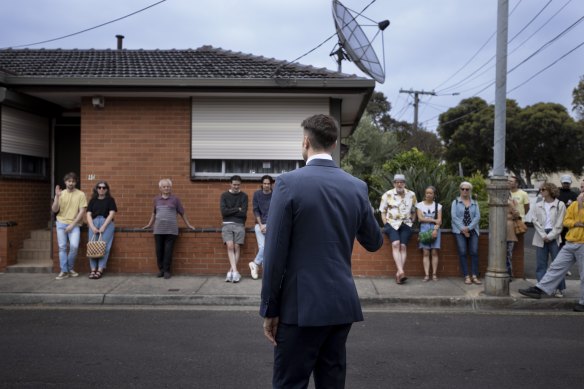The type of homeowner most likely to fall behind on their mortgage
Owner-occupiers are falling behind on their mortgages at greater rates than investors, figures from the credit ratings agency, S&P show.
The data reveals that 1.09 per cent of owner-occupiers are at least 30 days in mortgage arrears as of June 2024, compared to 0.79 per cent of investors.

Many investors have mitigated some of the financial pain caused by rising rates by increasing their tenant’s rent.Credit: Arsineh Houspian
It comes as the Reserve Bank kept the cash rate on hold at 4.35 per cent on Tuesday, leaving borrowers waiting for the relief of cuts that are unlikely to come for months.
S&P Global Ratings director Erin Kitson said many investors tend to be in a better position to keep up with their repayments.
“If you look at the profile of a typical investor-borrower they are often more highly represented in older age cohorts and higher income quartiles. So, their overall debt-serving capacity is probably likely to be higher than an owner-occupier,” she says.
Investors tend to have a stronger asset base, more secure employment and fewer or none of the expenses associated with a young family with children, adds AMP chief economist Shane Oliver.
“They are often more financially savvy, and the cost of higher mortgage rates is partially offset by being able to claim a tax deduction for their interest payments,” he said.
Many investors have also been able to mitigate some of the financial pain caused by rising rates by increasing their tenant’s rent, Canstar data insights director Sally Tindall said, which is something the current housing crisis enabled.
“In a market flush with available rental properties, raising rent can be a precarious exercise for an investor as the existing tenants may choose to move to a cheaper property,” she said. “However, a lack of housing stock and an influx of immigrants has driven rental vacancy rates in some areas to near-record lows, giving investors cover to put up their rental prices.”
While investors have more room to move and greater flexibility to mitigate some of the financial pain caused by higher mortgage rates, owner-occupiers face a very different reality, Tindall said.
“While mortgage arrears rates are still relatively low, particularly considering the sharp rise to the cash rate, of those borrowers in arrears, owner-occupiers are over-represented.
“This is unsurprising as those who live in their own home with a mortgage have fewer options at their disposal to manage rising interest rates compared to investors.”
Despite this, there is no single category that borrowers in arrears come from, she explains – instead, a range of reasons may contribute.
Reasons include younger borrowers who haven’t had time to build up equity in their loan or cash buffers to fall back on and borrowers who took on big debts compared to their incomes when interest rates were at record lows and property prices were soaring.
“This was particularly problematic prior to November 2021 when APRA only required the banks to stress test new home loan applicants’ finances with a buffer of 2.5 percentage points – from November 2021 onwards the stress test was changed to 3 percentage points, which remains the case today,” Tindall said.
Any changes to family circumstances such as the arrival of a baby, change in work such as a bout of ill health, a switch to part-time work or the loss of a job can also play a role, she adds, as well as those who live in their own home with a mortgage, who “have fewer options at their disposal to manage rising interest rates compared to investors”.
While selling is often the last option for any borrower, “for many investors the decision to sell the property is an easier one to make, as the consequence of doing so isn’t likely to directly impact their own living situation,” Tindall said.
For owner-occupiers though, the property being their primary residence makes the decision more challenging.
“Not only do families have to tackle the difficult decision of where to live, which isn’t an easy one to make amidst a housing shortage, they’re also faced with the prospect of moving on from a home full of memories, potentially further away from friends and family, not to mention the added costs involved in selling the property, paying a rental bond or worse still, stamp duty and moving costs,” Kitson says.
“If the owner-occupier is looking to rent in the current rental market with lower vacancies and higher rents, this can make the process even more difficult.”